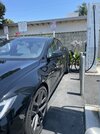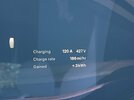And the comment about there being no reason for all the issues with CCS right now... I fully believe that. A big project like this should be tested to no end. The standard should be locked down before rolling out equipment and tested. Then new autos should be tested internally and maybe even externally by EA to be "certified" to work on their network. Any issues that DO show up should be fixed rapidly. There is no reason why EA had to have so many support calls that it accounted for 25% of all their charging sessions... that's just insane.
Again, I think you're conflating a number of issues:
- EA and other network general reliability issues, some of which aren't related to the plug type (can affect CHAdeMO too) like credit card reader, NFC, network or back end problems
- vehicle compatibility problems
- actual station problems that affect a particular station or one of its handles
- user error esp. since the workflow seems more involved and error prone than what's involved w/a CCS vehicle
- actual Setec compatibility problems: This isn't helped by the fact that there are 4 Tesla models floating around each with one of several different software versions for that vehicle and Setec adapters w/one of several firmware versions. And, over time, those vehicles receive newer versions of software from Tesla. This is besides a specific Tesla model (more true for older models) likely having gone thru several hardware revisions over time for any of the hardware involved with DC FCing.
Regarding testing, search
Electrify America Talks Charging Network Problems, Has Solutions for lab numerous times.
Automakers do testing of their EVs/PHEVs against charging equipment of various vendors. I obviously can't comment on Ford and VW in this case. As examples w/older vehcles for J1772, the e-Golf from a charging POV seemed buggy on J1772 (per a former Plugshare employee, see my post and actual experience at
Is there a term for driver leaving car in charging port for longer than suggested time? - My Nissan Leaf Forum). For J1772, BMW botched the on-board chargers on all of their i3's for the US (their second OBC is aka the KLE):
BMW Starts Replacing i3 KLE Onboard Charger To Achieve A 7.4 kW Charging Rate. They had to turn down the charging rate as a band aid until there was a new re-designed part.
Obviously, this Setec adapter hasn't had the benefit of a whole bunch of testing by the automaker (or Setec or the folks in South Korea, esp. in DC FCs deployed in the US) and Electrify America.
Where does that 25% figure come from? I've not needed to call them 25% of the time in order to charge my Bolt. However, sometimes there is a down/broken station when I'm attempting to charge and I call it in, while I charge on another.




